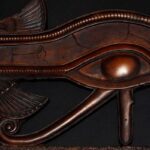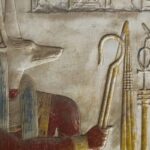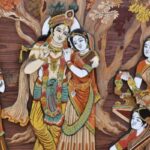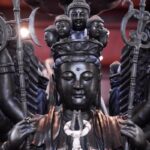We explain what the main gods of Ancient Egypt were, the characteristics of each one and the myths they starred in.
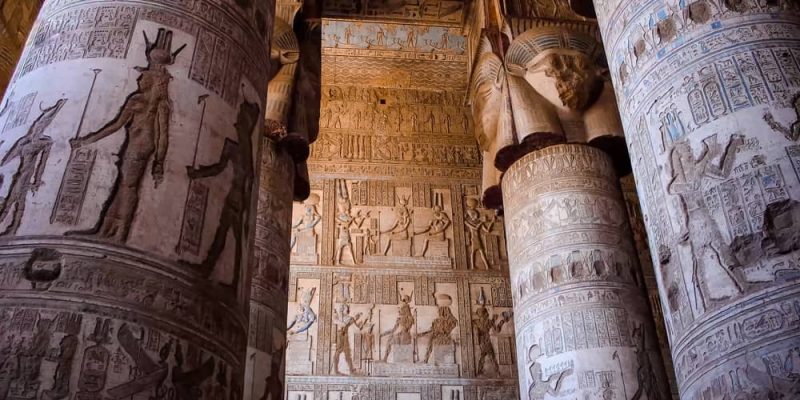
What were the main gods of Ancient Egypt?
The main gods of Ancient Egypt were Ra, Osiris, Isis, Seth, Horus, Nephthys, Thoth, Anubis, Bastet, Ptah, Hathor and Amun.
Ancient Egypt was one of the main agricultural civilizations of antiquity. It lived along the middle and lower reaches of the Nile River in northeastern Africa. Its rich and complex history spanned more than three millennia (3100 BC-30 BC) and, over time, its territorial extent varied significantly, but its main area of occupation was located between the Nile delta to the north and the first cataract of the Nile to the south, and between the extensive desert areas to the east and west of the river.
Ancient Egyptian society was deeply religious and clearly hierarchical. His political regime it was a monarchy theocratic headed by the pharaoh, who was revered by his subjects as a god as he was considered a manifestation of Horus and an intermediary between humans and the gods. The pharaoh was in charge of governing, dispensing justice, commanding the military forces and directing religious worship.
The religion Ancient Egypt was solar, cyclical, polytheistic and based on the notion of maatthat is, harmony or cosmic balance, the force that allowed the world to exist as such and that depended largely on the performance of the rituals offered to its numerous gods by the pharaoh and the priests. The gods of Ancient Egypt were complex, with diverse aspects that could often be combined, which is why sometimes a kind of fusion between gods and cults occurred.
The Egyptian gods embodied different aspects of nature and society and in addition to their official worship by priests and temples, they used to be invoked by private people through prayers and offerings to attend to private matters. The belief in the resurrection in the afterlife and funerary rites played a key role in the Egyptian worldview.
The main Egyptian gods with their characteristics are described below.
See also: Deity
Ra
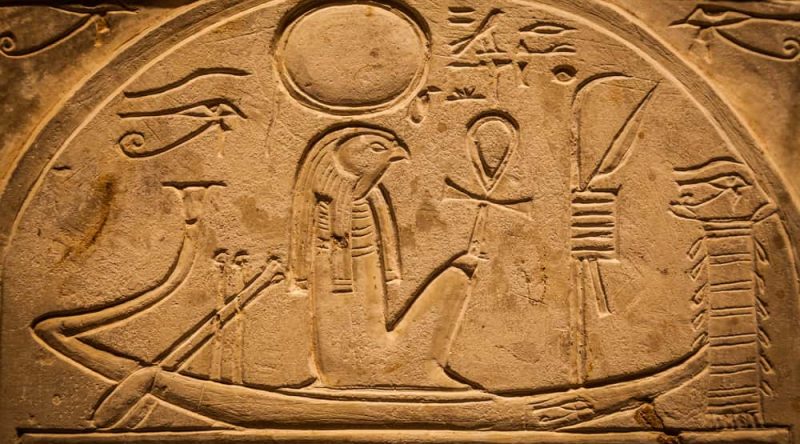
Egyptian god of the sun, giver of life and symbol of sunlight Ra was responsible for the eternal cycle of birth, death and resurrection, and one of the most important figures in the Egyptian cult from early times. He was associated with the pharaohs, who were considered his descendants.
According to Egyptian mythology, Ra traveled every day in his boat through the heavens, from east to west, and every night he entered the underworld, where he had to defeat the serpent Apep or Apophis in order to re-emerge at dawn the next day. Their different locations in the sky were in turn associated with other manifestations of the solar god: Jepri at dawn, Ra-Horajty at noon, and Atum at dusk.
Initially, Ra was just one more solar deity of the several that existed, but his connection with the official cult of the pharaohs during the V Dynasty (c. 2500 BC C.-2350 BC C.) gave him a main place within the Egyptian pantheon. This place was strengthened during the New Kingdom (1550 BC-1070 BC), through its assimilation with the Theban god Amun, when he became Amun-Ra. He was especially venerated in Heliopolis, the main seat of his cult and in the Abu Gurab region, both towns located in northern Egypt.
Ra was generally represented as a man with a falcon's head and a solar disk on it. According to myth, its origin dates back to the moment of creation itself, when the world was a dark place in which there was only a large expanse of water (Nun). At that time, a large and shiny egg emerged from within the waters (in some versions it is a lotus flower), and from this egg Ra was born, whose first action was to illuminate the horizons.
With his word the wind (Shu), the rain (Tefnut) and the Nile (Hapi) were also formed, and then one by one the other elements of the earth, including the first human beings. So, Ra took human form and ruled Egypt as the first pharaoh.
Osiris

One of the main figures in Egyptian mythology was the god and ancient mythical king Osiris, who was considered the king of the underworld and was associated with vegetation, agricultural fertility and resurrection. His mythological story shaped numerous traditions and celebrations of the Egyptian religion.
His cult acquired predominance in the 25th century BC. C and lasted until the 6th century AD. C., when the last temple consecrated in honor of Isis and Osiris was closed by order of the Byzantine emperor Justinian. His main place of worship was located in the city of Abydos where an annual festival was held that consisted of moving the statue of Osiris from his temple to a tomb that was believed to belong to him.
According to the myth, Osiris He was the son of Nut, the Egyptian goddess of the sky, and her brother Geb, the god of the earth. Osiris' brothers were Seth, Nephthys and Isis, and the latter was also his wife. Of all of them, Osiris was the favorite son, and that led him to succeed Geb on the throne of Egypt, crowned by Atum-Ra himself. This is how the Egyptian civilization began, since Osiris introduced laws and taught humanity how to worship the gods.
However, his brother Seth, ruler of the foreign, hostile desert regions, planned his assassination and drowned him in the waters of the Nile, then dismembered him and scattered his remains throughout Egypt.
Seth thus usurped the Egyptian throne, while Isis and Nephthys, with the help of the gods Thoth and Anubis, collected the body parts of Osiris, put them together and embalmed him. Once mummified, Osiris revived and became the ruler of the kingdom of the dead. However, he had a son with Isis, Horus, who dedicated himself to fighting Seth for the throne of Egypt and managed to restore order.
Osiris He was represented as a pharaoh in human form (although often green or black-skinned, to indicate their association with the earth, vegetation and regeneration), and many times like a mummified pharaoh. His figure was strongly linked to the idea of rebirth, the restart of natural cycles and the germination of vegetation after burying the seed.
Isis
Isis She was the most revered goddess of the Egyptian religion whose cult spread even to the Greco-Roman world, in syncretism with other deities. Her role in the myth of Osiris was decisive, as she not only helped reunite the dismembered corpse of her husband and brought him back to life, but she also fathered her son and heir, Horus, who became the legitimate king of Egypt.
It was invoked in most rituals egyptian mortuaries since she was expected to help the deceased in the transition to the underworld, just as she had helped her husband Osiris. At the same time, it was goddess of motherhood and marriage, and protector of humanity.
It was associated with magic and wisdom and her actions to protect Horus and the corpse of Osiris presented her as a fierce defender of the sacred.
The figure of Isis was complex and went through many stages throughout Egyptian history, since her popularity led her to take on traits of other local goddesses, and even to hybridize with goddesses from other neighboring religions, especially after the Greek colonization of Egypt.
That is why their modes of representation could vary substantially, although in general the Egyptians represented her as a woman who carried on her head the hieroglyphic sign in the shape of a throne which was part of his name. Furthermore, he used to carry a staff and an Egyptian cross or anj.
seth
Seth or Seth was the Egyptian god of chaos, of the uncontrollable, of brute force and of desert. He was the brother of Osiris, Isis and Nephthys, and in some versions of the myth also the husband of the latter.
He was the murderer of his brother Osiris, which triggered the mythological cycle of combat between Horus (son of Osiris) and Seth for the throne of Egypt. This fact also caused the mummification and resurrection of Osiris, a central idea in Egyptian religion, as it explained the origin of the practice of mummification.
Despite being the murderer of Osiris, Seth was a god revered by Egyptian society and considered a protector, especially in times of war. He also helped Ra fight the serpent Apep on his nightly boat trip. Their main sanctuaries were at Avaris and Pi-Ramesses (to the north), and Nagada (to the south)
seth He was represented as a man with the head of an unidentified or imaginary animal and sometimes with the complete form of this animal. It could also manifest itself in the form of animals such as the hippopotamus, the crocodile, the pig, the donkey, the bull or the snake.
Generally, he was represented carrying a scepter in one hand. was (a straight stick forked at the lower end and with a head of a fantastic animal at the upper end), and in the other hand a anj (ansada or Egyptian cross), the Egyptian symbol of life.
Despite fulfilling the role of antagonist in the mythological story, Seth was not an evil god, but a chaotic one. His motives for murdering his brother were due to the unequal distribution of Egyptian lands, since the fertile territories had been granted to Osiris and the desert regions to Seth. As punishment for his actions, He was banished by Horus and condemned to live in the desert.
Horus
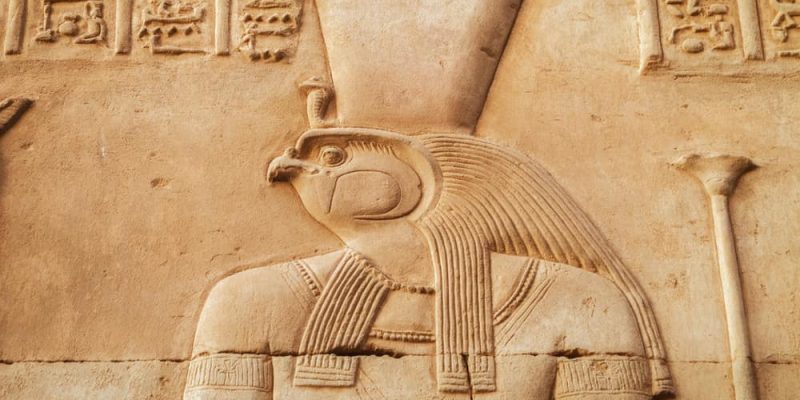
Son of Isis and Osiris, Horus was a celestial god, associated with war and hunting, but also with the monarchical institution because according to myth he had inherited the throne of Egypt from his late father and each new pharaoh identified himself with him.
He was represented as a man with the head of a falcon who usually wore the double crown of the Egyptian pharaoh, and sometimes simply as a falcon or as a solar disk with two wings spread.
According to Egyptian myth, Horus was hidden and protected by Isis at birth, and was left in the care of the god Thoth, to make him a formidable and wise warrior. Thus, upon reaching the age of majority, Horus defeated Seth and regained his father's throne. The fight cost him his left eye, which was healed by Thoth and which Horus presented to his father as an offering to restore his sight and revitalize him.
Initially, Horus was the god of Lower Egypt (the north) and Seth of Upper Egypt (the south), but Horus finally won and was awarded the double crown that symbolized dominion over the entire territory, with Isis or Hathor as queen.
In some ways, Horus was the Egyptian god closest to human beings, since the pharaoh identified with him and acted as an intermediary between human beings and the gods.
See also: Eye of Horus
Nephthys
The origin of the goddess Nephthys is not very clear. Her name translates as “mistress of the temple,” something similar to a priestess. In the myth of Osiris she is described as the sister of Isis and wife of Seth with whom he fathered the god Anubis (although in some variants Anubis' father is Osiris or Ra).
In other versions of the myth, she was also Osiris's lover, although disguised as his sister Isis to deceive him, an action that would have motivated Seth to murder his brother.
In any case, after the dismemberment of Osiris, Nephthys mourned her dead brother and worked together with Isis to find and reunite his scattered parts, as well as to perform the necessary rites to bring him back to life.
Like Isis, Serket (or Selkis) and Neith, Nephthys She was a goddess linked to the funerary world, and at the same time she was a festive deity which was celebrated with beer. His help could also be invoked during labor. Their main places of veneration were Diospolis Parva, Komir, Sepermeru and Memphis
Thoth
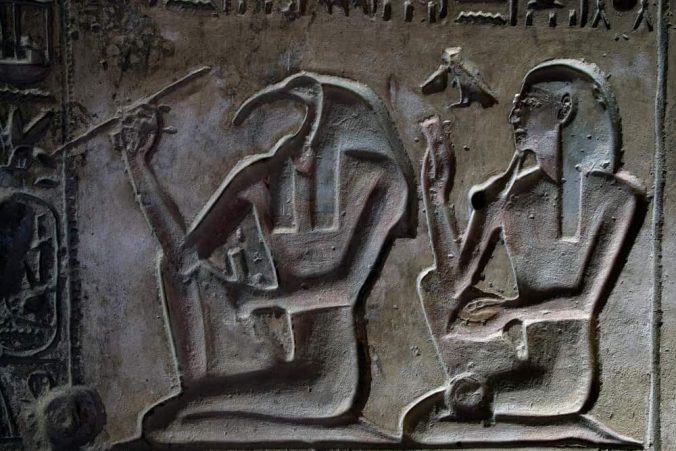
Egyptian god of wisdom, hieroglyphic writing, magic and law Thoth was a very ancient deity in Egyptian tradition, whose female equivalent was Seshat. According to Egyptian mythology, Thoth was paired with the goddess Maat, who symbolized balance, harmony and cosmic justice. Together they enjoyed authority above the other gods.
Thoth was a lunar god who performed the work of scribe and advisor to the gods and patron of scribes. In the underworld, he kept the record of the judgment of the deceased.
He was represented as a man with the head of an ibis, or like a baboon or an ibis, and often carried a reed brush and palette with which he wrote hieroglyphs.
The first month of the lunar calendar was consecrated to Thoth, and He was worshiped in the towns of Hermopolis Magna, Hermopolis Parva, Sarabit el-Khadim and Tuna el-Yebel.
Anubis
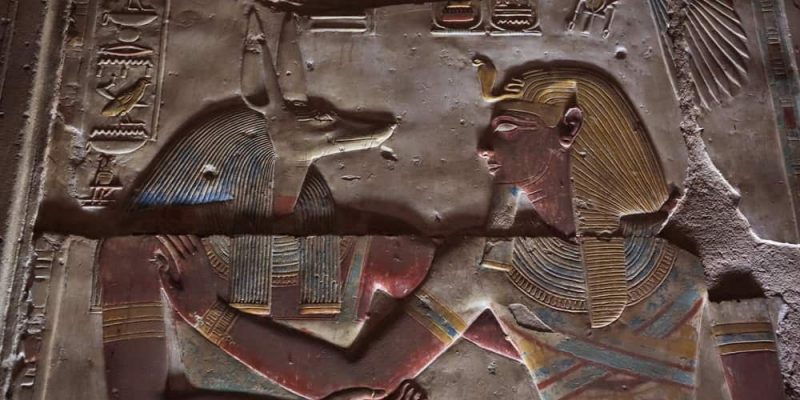
Anubis was the Egyptian god who guarded the tombs and the underworld. He was a very important funerary deity, whom He was worshiped throughout Egypt during the three millennia that this civilization lasted.
The mythological origins of Anubis are uncertain: in some cases he is considered the illegitimate son of Nephthys and Osiris; in others he is identified as the son of Nephthys with her husband Seth; and sometimes it appears as the fruit of the union between Nephthys and Ra.
Anubis He participated in the embalming of Osiris and thus inaugurated the practice of mummification so important in Egyptian tradition. He was considered the guardian of the deceased, whom he welcomed into the underworld. He was in charge of weighing the hearts of the deceased on a scale against a feather that represented truth and justice. If the heart was lighter than the feather, the deceased was considered worthy of entering the kingdom of Osiris.
Commonly, he was represented as a jackal or a man with the head of a jackal, a typical scavenger animal of the region.
Bastet
Worshiped since the years of the Second Dynasty (c. 2900 BC C.-2700 BC C.), Bastet was the goddess of love, harmony and protection invoked to guard homes and temples.
I know it generally represented as a woman with the head of a cat or lioness and he used to have a musical instrument (a sistrum). Sometimes she was represented simply as a cat, since these animals were sacred to her.
Daughter of Ra and associated with the warm rays of the sun, she was a beneficent but unpredictable goddess, who oscillated between loving protection and ferocity often assimilated with the goddess Sejmet (leonine deity of war and destruction).
Bastet was mentioned in the Pyramid Texts, the Book of the Dead and other liturgical texts. His main cult took place in the city of Bubastis in the Nile Delta, where a cemetery of mummified cats was found.
Ptah
Ptah was a creator god, patron of artisans, bricklayers and architects It was considered from the beginning of Egyptian history the local god of Memphis where he had his main cult center, but he was worshiped throughout Egypt.
He was represented as a man with a straight beard wrapped in a shroud standing on a pedestal and holding a scepter was between the hands, which symbolized dominance and power.
Ptah was the husband of Sejmet and father of Nefertum. It occupied a very important place in the Egyptian cult throughout its history, since He was considered the maker of the other gods, the builder of cities and temples and the inventor of religious rituals such as the ceremony of opening the mouth (a funerary rite).
Hathor
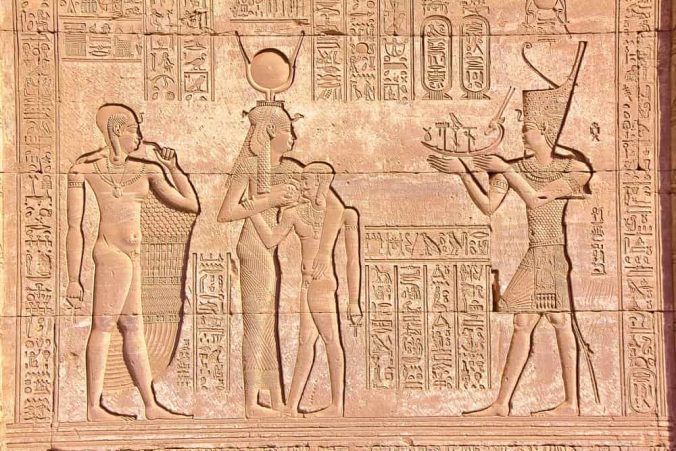
Hathor was one of the great Egyptian goddesses, linked to the celestial vault and with different roles in each era of Ancient Egypt. It was associated with music, dance, joy, love, sexuality and motherhood.
According to various myths, she could be the consort of different gods (including Ra and Horus) and mother of their children, or mother of their earthly representatives (the pharaohs), or mother of Ra and Horus themselves.
Generally, She was represented as a woman with cow horns on her head and a solar disk between them or directly like a cow, a lioness or a sycamore (a fig tree typical of Egypt).
Hathor had more temples built than any other goddess, and she often had dedicated spaces in the temples of her male consorts. One of its most important temples was Dendera.
During the New Kingdom, many of its characteristics were assumed by other deities, such as Isis or Mut, but its cult continued to be important. She was especially revered by pregnant women since it was believed that it helped them give birth.
Amon
Amun was one of the gods considered primordial and creators. Its name is believed to mean “the hidden one,” perhaps because of its association with the invisible power of the wind. Its first mention is attested in the Pyramid Texts, around 2400 BC. C., and later gained prominence as the main deity of the city of Thebes in southern Egypt.
In the New Kingdom, he was held responsible for the military successes of the pharaohs and rose to a position of great importance throughout Egyptian territory, and even in some conquered areas. At this time, it was associated with the solar cult, took the form of Amun-Ra and great temples were dedicated to him, such as that of Karnak.
He was usually represented in human form, with a crown with two vertical feathers and sometimes with blue skin like lapis lazuli (an imported rock that was considered worthy of the gods). In his form as Amun-Ra, he also used to wear a solar disk on his head. Furthermore, it was associated with some animals, especially the ram.
Continue with: Aztec gods
References
- Baines, JR and Dorman, P.F. (2023). Ancient Egyptian Religion. Encyclopedia Britannica. https://www.britannica.com/
- Hart, G. (2005). The Routledge Dictionary of Egyptian Gods and Goddesses. Second Edition. Routledge.
- Pinch, G. (2002). Handbook of Egyptian Mythology. ABC-CLIO.
- Tyldesley, J. (2011). Myths and legends of ancient Egypt. Criticism.
- Wilkinson, R.H. (2004). All the gods of Ancient Egypt. Oberon.

